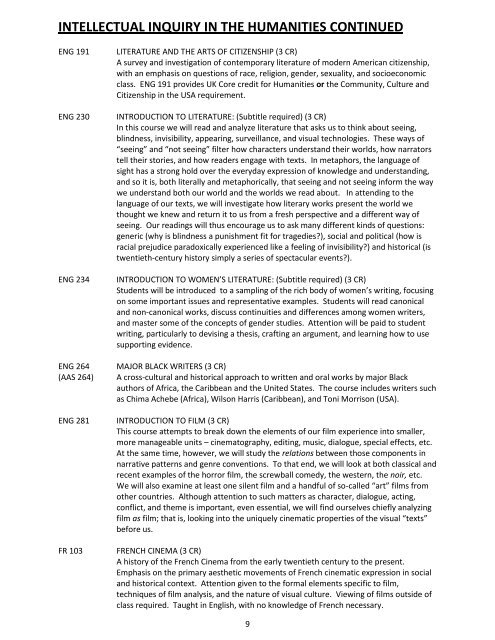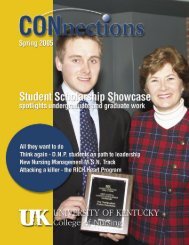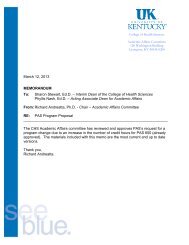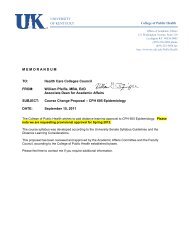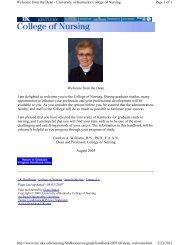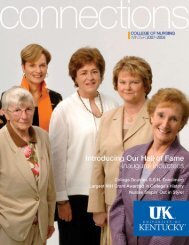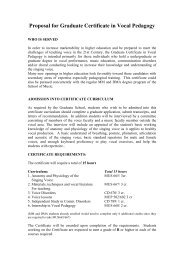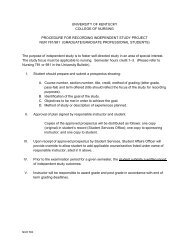UK Core - University of Kentucky
UK Core - University of Kentucky
UK Core - University of Kentucky
You also want an ePaper? Increase the reach of your titles
YUMPU automatically turns print PDFs into web optimized ePapers that Google loves.
INTELLECTUAL INQUIRY IN THE HUMANITIES CONTINUEDENG 191ENG 230ENG 234ENG 264(AAS 264)ENG 281FR 103LITERATURE AND THE ARTS OF CITIZENSHIP (3 CR)A survey and investigation <strong>of</strong> contemporary literature <strong>of</strong> modern American citizenship,with an emphasis on questions <strong>of</strong> race, religion, gender, sexuality, and socioeconomicclass. ENG 191 provides <strong>UK</strong> <strong>Core</strong> credit for Humanities or the Community, Culture andCitizenship in the USA requirement.INTRODUCTION TO LITERATURE: (Subtitle required) (3 CR)In this course we will read and analyze literature that asks us to think about seeing,blindness, invisibility, appearing, surveillance, and visual technologies. These ways <strong>of</strong>“seeing” and “not seeing” filter how characters understand their worlds, how narratorstell their stories, and how readers engage with texts. In metaphors, the language <strong>of</strong>sight has a strong hold over the everyday expression <strong>of</strong> knowledge and understanding,and so it is, both literally and metaphorically, that seeing and not seeing inform the waywe understand both our world and the worlds we read about. In attending to thelanguage <strong>of</strong> our texts, we will investigate how literary works present the world wethought we knew and return it to us from a fresh perspective and a different way <strong>of</strong>seeing. Our readings will thus encourage us to ask many different kinds <strong>of</strong> questions:generic (why is blindness a punishment fit for tragedies?), social and political (how isracial prejudice paradoxically experienced like a feeling <strong>of</strong> invisibility?) and historical (istwentieth-century history simply a series <strong>of</strong> spectacular events?).INTRODUCTION TO WOMEN’S LITERATURE: (Subtitle required) (3 CR)Students will be introduced to a sampling <strong>of</strong> the rich body <strong>of</strong> women’s writing, focusingon some important issues and representative examples. Students will read canonicaland non-canonical works, discuss continuities and differences among women writers,and master some <strong>of</strong> the concepts <strong>of</strong> gender studies. Attention will be paid to studentwriting, particularly to devising a thesis, crafting an argument, and learning how to usesupporting evidence.MAJOR BLACK WRITERS (3 CR)A cross-cultural and historical approach to written and oral works by major Blackauthors <strong>of</strong> Africa, the Caribbean and the United States. The course includes writers suchas Chima Achebe (Africa), Wilson Harris (Caribbean), and Toni Morrison (USA).INTRODUCTION TO FILM (3 CR)This course attempts to break down the elements <strong>of</strong> our film experience into smaller,more manageable units – cinematography, editing, music, dialogue, special effects, etc.At the same time, however, we will study the relations between those components innarrative patterns and genre conventions. To that end, we will look at both classical andrecent examples <strong>of</strong> the horror film, the screwball comedy, the western, the noir, etc.We will also examine at least one silent film and a handful <strong>of</strong> so-called “art” films fromother countries. Although attention to such matters as character, dialogue, acting,conflict, and theme is important, even essential, we will find ourselves chiefly analyzingfilm as film; that is, looking into the uniquely cinematic properties <strong>of</strong> the visual “texts”before us.FRENCH CINEMA (3 CR)A history <strong>of</strong> the French Cinema from the early twentieth century to the present.Emphasis on the primary aesthetic movements <strong>of</strong> French cinematic expression in socialand historical context. Attention given to the formal elements specific to film,techniques <strong>of</strong> film analysis, and the nature <strong>of</strong> visual culture. Viewing <strong>of</strong> films outside <strong>of</strong>class required. Taught in English, with no knowledge <strong>of</strong> French necessary.9


